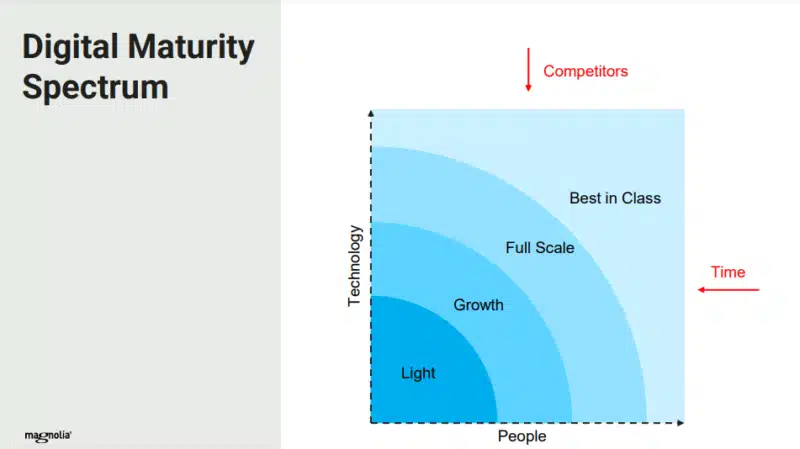How marketers can build their brand’s digital maturity
A brand's digital maturity goes beyond digital transformation.
“Consumers have become a lot more digitally mature than they were just a couple of years ago. All of that stuff went into overdrive, and it’s probably not going to go back.” Salvador Lopez, Director of Marketing, Americas at CMS provider Magnolia, was speaking at our MarTech conference
Digital maturity growth is a big factor among brands as well. These changes, spurred on by the COVID-19 pandemic and technological developments, have become important predictors of brand success across the digital landscape. The bigger picture points to digital maturity as the main differentiator — even more so than digital transformation.
“You hear a lot of talk of digital transformation that has to get that done rather quickly,” said Lopez. “But we wanted to focus more on digital maturity because that’s really the more holistic view.”
What is digital maturity?
Digital maturity isn’t just about having the latest technology in your marketing stack. It’s an overarching quality that represents how well your brand’s operations, people, and strategy are integrated within a digital strategy.
Lopez cited the Boston Consulting Group’s helpful definition of digital maturity, which states that it’s a measure of an organization’s ability to create value through digital. This includes every place a business generates that value, including its cost-efficiency, customer satisfaction, and revenue growth.
Measuring your brand’s digital maturity
“I don’t think I could stress enough that digital maturity is indeed a spectrum; it’s not some sort of binary thing,” Lopez said.
Lopez pointed to a helpful illustration showing the different stages of digital maturity brands find themselves in. These areas of the spectrum are measured in terms of brand relationships between their people and technology assets.

He noted that not every brand should be at the highest end of the spectrum. The real need is for brands to measure how their people and technology work together to achieve results.
Here are some of the ways Lopez says marketers can measure their brand’s digital maturity level.
- Assess business requirements, then tranlate them into technical requirements;
- Pinpoint digital areas of focus, such as assets, optimization, and automation; and
- Determine which roles need to be filled based on business and technical requirements.
Once each of these items is addressed, marketers can more easily determine how well their people, roles, and technology fit together in a digital framework.

Increasing brand digital maturity
While some brands can operate efficiently at lower digital maturity levels, savvy marketers may see business growth opportunities at higher levels. Here are three specific tasks Lopez recommends brands at each level of maturity undergo.
Low digital maturity: Assess technology and team roles
“This could be the time to start to at least get into the mindset of leveraging data to your advantage,” said Lopez.
He added, “Some really good starting points could be tracking your email metrics and more of the basic site analytics.”
By analyzing their marketing technology’s effectiveness, brands with low digital maturity can leverage that data into better tool purchases. At the same time, these brands should take stock of how well their team members are working with their technologies, making changes when necessary.
Medium digital maturity: Identify KPIs and objectives
Brands becoming more mature may find themselves growing too quickly, which can sometimes hamper their processes. Identifying objectives can help get their marketing back on track.
“A lot of times you have the right things in place; it’s just the execution of it,” said Lopez. “So let’s say you have your martech stack in place; you have every component you could theoretically need. But do you have the KPIs in place for each of these solutions?”
A business could create the most well-crafted digital marketing machine in the world, but without clear KPIs their growth will remain stagnant.
High digital maturity: Develop a reliable, actionable data strategy
Marketers running at high maturity may struggle to find ways to push their brands to the next level. Lopez says those in this situation should focus on developing rich content and data pools, and streamlining operations for multi-channel delivery.
“It’s being thorough about things, doing deep scale analysis,” Lopez said, “conducting the deep evaluation of your data integrity and finding that single source of truth, and making sure that you’re not making flawed assumptions off of the data that you’re currently collecting.”
He added, “What a lot of companies tend to do is use their content management system as a hub for accessing their analytics data, their digital assets, and data from their CRM. Combining it into one platform creates greater efficiencies for your organization.”
Watch the full presentation from our MarTech conference here (free registration required).
Digital asset management platforms: A snapshot
What is it? Anyone who’s struggled to find a file on their computer or shared drive understands the pain of tracking down content. And when you consider the sheer amount of files you need to sort through when many versions are created to resonate with specific audiences, these tasks can feel overwhelming. Digital asset management platforms simplify these tasks by bringing all of your marketing content together.
Why are they important? Marketers are creating engaging content for more channels than ever before, which means the software used to manage these assets is gaining importance. What’s more, the communications between businesses and their customers are increasingly digital. Marketing content today is created in a wide variety of formats and distributed wherever consumers are digitally connected.
Why we care. When those creating and using content aren’t near one another, having a central repository for assets is helpful. Finding the right content for your audience is made simpler when each version is organized in the same location. For these reasons and more, your marketing operations could benefit from adopting a digital asset management system.
Contributing authors are invited to create content for MarTech and are chosen for their expertise and contribution to the search community. Our contributors work under the oversight of the editorial staff and contributions are checked for quality and relevance to our readers. MarTech is owned by Semrush. Contributor was not asked to make any direct or indirect mentions of Semrush. The opinions they express are their own.
Related stories